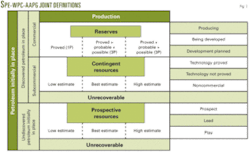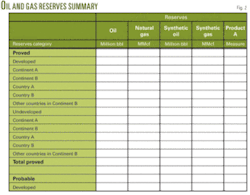The recently updated US Securities and Exchange Commission reserves reporting requirements for oil and natural gas companies attempt to provide investors with more meaningful and comparable disclosures.
The updated rules will come into effect for filings after Jan. 1, 2010, unless SEC delays the date.
This update modifies oil and gas reporting disclosures adopted in 1978 and 1982 based on Regulation S-K and Regulation S-X under the Securities Act of 1933 and the Securities Exchange Act of 1934, as well as Industry Guide 2.
SEC says, “The revisions are intended to provide investors with a more meaningful and comprehensive understanding of oil and gas reserves, which should help investors evaluate the relative value of oil and gas companies.”
It adds, “The amendments concurrently align the full-cost accounting rules with the revised disclosures. The amendments also codify and revise Industry Guide 2 in Regulation S-K. In addition, they harmonize oil and gas disclosures by foreign private issuers with the disclosures for domestic issuers.”
Most definitions in the updated rules are consistent with the Petroleum Resource Management System published in 2007 and developed by the Society of Petroleum Engineers, World Petroleum Council, American Association of Petroleum Geologists, and Society of Petroleum Evaluation Engineers.
Fig. 1 shows the PRMS reserves classification. The SEC rules cover disclosure of economic producible reserves, which SEC says unlike commercial reserves do not include factoring in the rate of return required by a particular company.
The new rules require companies to disclose proved developed reserves and proved undeveloped reserves (PUDs) and to make optional the disclosure of probable developed reserves, probable undeveloped reserves, and possible undeveloped reserves.
The rules continue to prohibit disclosure of oil or gas resources other than reserves in filings with the SEC unless a foreign or state law requires disclosing such information.
The updated rules in particular eliminate:
- Single-day yearend pricing for determining economically producible reserves.
- Exclusion for extraction of bitumen and other nontraditional resources from the definition of oil and gas producing activities.
- Limitations on technologies for determining reserves classification.
- Restrictions for disclosing crude classifications other than proved reserves.
Yearend pricing
The update removes the yearend price. Instead, companies will need to determine economically producing reserves with a 12-month average price based on each month’s closing prices on the first day of each month or prices defined in existing contracts.
For instance, a recent ConocoPhillip news release said that based on the Dec. 31, 2008, prices, it expects to have to remove reserves from the proved category associated with investments that remain an important part of the company’s upstream portfolio.
On the other hand, if the 12-month-average pricing were already in effect, without considering other changes in the new SEC rules, ConocoPhillips would expect to have minimal reserves changes.
SEC notes that its “objective of reserves estimation is to provide the public with comparable information about volumes, not fair value, of a company’s reserves available to enable investors to compare the business prospects of different companies. The use of a 12-month average historical price to determine the economic producibility of reserves quantities increases comparability between companies’ oil and gas reserve disclosures, while mitigating any additional variability that a single-day price may have on reserve estimates.”
SEC revised both its disclosure rules and its full-cost accounting rules related to oil and gas reserves to use a single price based on a 12-month average. It also will coordinate the changes with the staff of the Financial Accounting Standards Board (FASB) and will consider delay of the compliance date if necessary.
Nontraditional resources
The update eliminates the exclusion of oil and gas producing activities from nontraditional or unconventional sources such as bitumen extracted from oil sands and oil and gas extracted from coal and shales.
The new rules allow a company to include in reserves coal and oil shale intended for conversion into oil and gas. SEC prohibits companies from including these resources if they will not be converted into oil or gas, such as when these resources are converted directly into electricity.
Because of their higher production costs and greater sensitivity to economic conditions, SEC will require companies to list these nontraditional reserves separately from conventional oil and gas reserves, as shown in Fig. 2.
SEC also revised its definition of oil and gas producing activities to include processing or upgrading of natural resources from which synthetic oil or gas can be extracted. It, however, excluded from the definition:
- Transporting, refining, processing (other than field processing of gas to extract liquid hydrocarbons and the upgrading of natural resources extracted other than oil or gas into synthetic oil or gas) or marketing oil and gas.
- Production of natural resources other than oil, gas, or natural resources from which synthetic oil and gas can be extracted.
- Production of geothermal steam.
Technology
SEC’s new rules allow companies to use new reliable technologies for establishing reasonable certainty of proved reserves. The definition of proved oil and gas reserves also includes provisions for establishing levels of lowest known hydrocarbons and highest known oil through reliable technology other than well penetrations.
SEC says it recognizes that “technologies have developed and will continue to develop, improving the quality of information that can be obtained from existing tests and creating entirely new tests that we cannot yet envision. Thus, the new definition of the term ‘reliable technology’ permits the use of technology (including computational methods) that has been field tested and has demonstrated consistency and repeatability in the formation being evaluated or in an analogous formation.”
This new standard permits use of a new technology or combination of technologies once a company can establish and document the reliability of that technology or combination of technologies.
The new rules require companies to disclose in a concise summary the technologies used to create the reserves estimate, although they will not require companies from disclosing proprietary technologies at a level that would cause competitive harm.
Reserve classification
The new rules define proved developed oil and gas reserves as those that can be recovered through existing wells with existing equipment and operating methods or that can be recovered in other ways through extraction technology installed and operational at the time of the reserves estimate.
The final rule also allows reserves to be classified as developed if the cost of any required equipment is relatively minor compared to the cost of a new well.
For undeveloped oil and gas reserves, the new rules will permit companies to claim proved reserves beyond spacing areas immediate adjacent to developed areas if the company establishes with reasonable certainty that these reserves are producible economically.
SEC adopted the definition of “reasonable certainty” that permits use of both deterministic methods and probabilistic methods for estimating reserves.
The new rules also allow companies to include in proved undeveloped reserves quantities that can be recovered through improved recovery projects.
The new rules contain the option for companies to disclose probable and possible reserves.
The final rules define the term reserves “as the estimated remaining quantities of oil and gas and related substances anticipated to be economically producible, as of a given date, by application of development projects to known accumulations. In addition, there must exist, or there must be a reasonable expectation that there will exist, the legal right to produce or a revenue interest in the production of oil and gas, installed means of delivering oil and gas or related substances to market, and all permits and financing required to implement the project.”
SEC also notes that companies should not assign reserves “to adjacent reservoirs isolated by major, potentially sealing, faults until those reservoirs are penetrated and evaluated as economically producible and that reserves should not be assigned to areas that are clearly separated from a known accumulation by a nonproductive reservoir.”
The new rules require companies to disclose reserves by appropriate geographic area under a company’s particular circumstances such as individual country, groups of countries within a continent; or within a continent.
The final rules require disclosure of production in each country or field containing 15% or more of the company’s proved reserves unless prohibited by the country in which the reserves are located. The 15% threshold is based on the company’s total global oil and gas proved reserves, rather than on individual products.
Also to avoid compelling a company to provide, in effect, field disclosure, the rule does not require disclosure of reserves in a country containing 15% of the company’s reserves if that country prohibits disclosure of reserves in a particular field and disclosure of reserves in that country would have the effect of disclosing reserves in particular fields.


